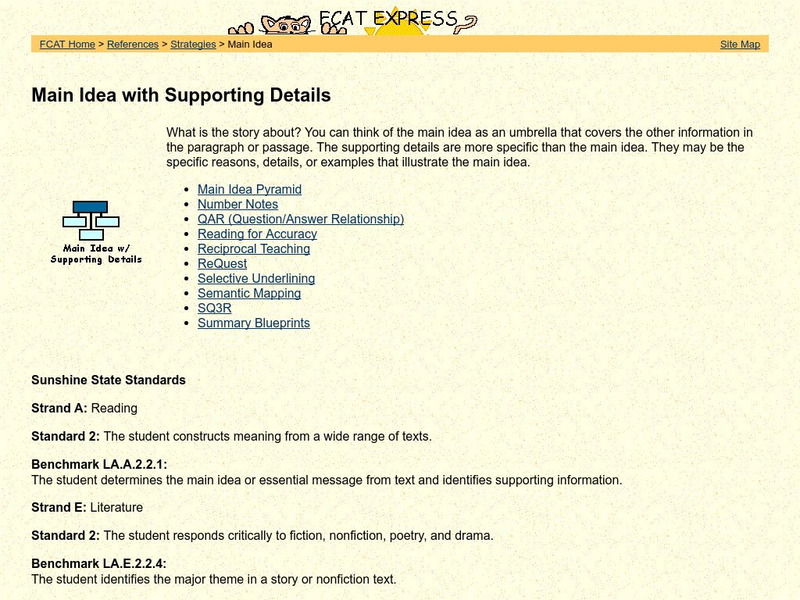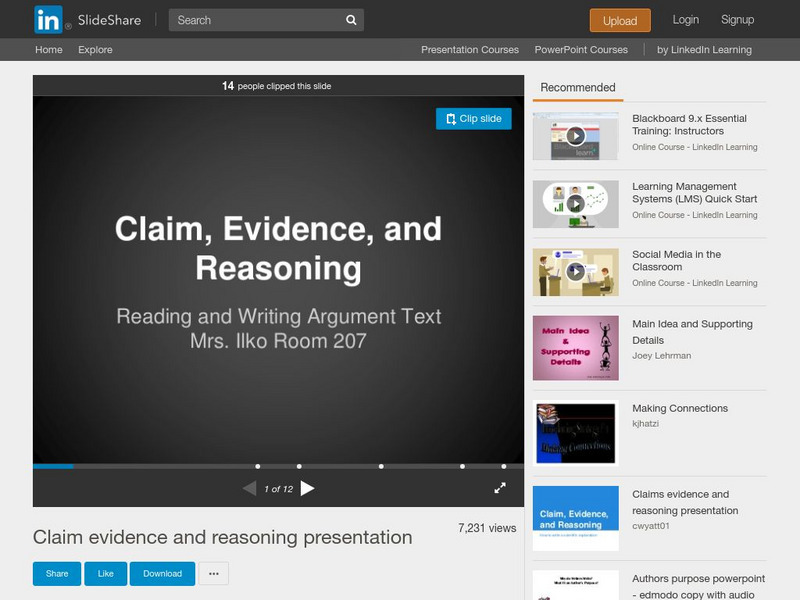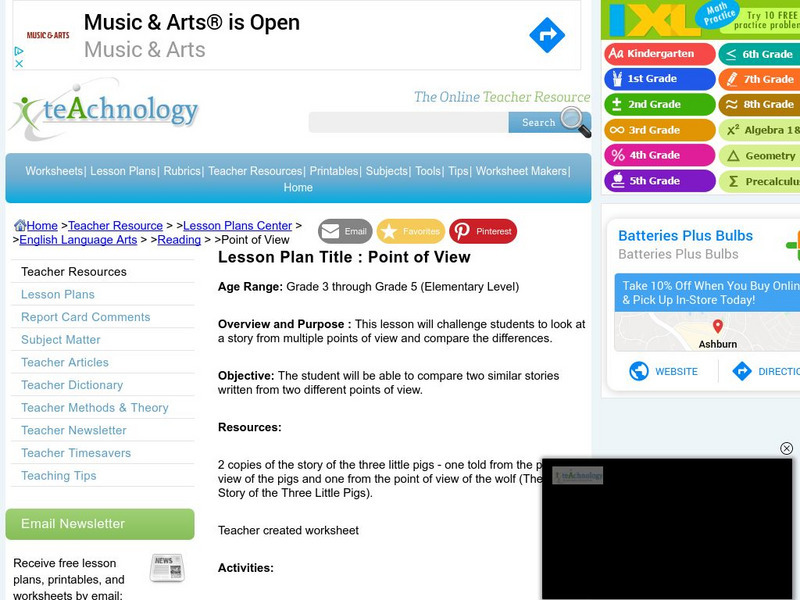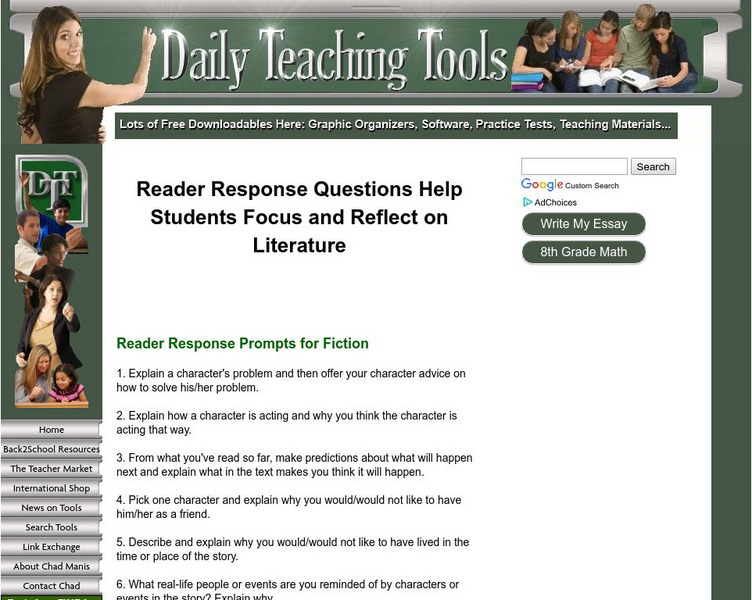Other
Carson Newman College: Close Reading of a Literary Passage [Pdf]
Provides a number of questions that students can ask themselves about a literary passage when doing a "Close Reading" and following this with an organized piece of writing. CCSS.ELA-Literacy.CCRA.R.5
Pennsylvania State University
Pennsylvania State University (Dr. Mc Clennen): How to Do a Close Reading
This guide is written for college students, but should be very useful for upper level high school students as well. The writer first describes fourteen steps to take in doing a close reading, then provides six pieces of advice on how to...
E Reading Worksheets
E Reading Worksheets: Text Structure Activities
Numerous links related to analyzing text structures are provided on this site. Lesson plans, PowerPoint slides, graphic organizers, rubrics, and quizzes related to text structures are also provided to support students while analyzing...
Curated OER
Mc Graw Hill: Part 1: Reading Literature: Show Understanding of Text
This quick lesson from the Common Core Literacy eHandbook teaches students what questions to ask and how to answer questions to show your understanding of literature.
Other
Curriculum Associates: Determining Theme or Central Idea [Pdf]
For this reading comprehension lesson unit, students are guided in learning how to find the main theme or idea of a text and understanding how details in the text convey that. Includes lots of exercises and examples, as well as...
TES Global
Blendspace: rl.k.5 Recognize Common Types of Texts (e.g., Storybooks, Poems).
In this module, students will read two texts on the topic of pancakes and distinguish between the text that is a storybook and the text that is a poem.
Read Works
Read Works: "Lon Po Po" and "A Tricky Monkey"
[Free Registration/Login Required] Students will read "Lon Po Po" and "A Tricky Monkey" and answer comprehension questions based on these fictional stories. This unit meets multiple Common Core Reading Standards for 3rd-grade literature.
Sophia Learning
Sophia: Evaluating the Connotation
This lesson focuses on evaluating the connotation of a vocabulary word. It defines connotation and gives an example. It details three steps: read the word in context, determine the tone of the overall reading, and compare the tone with...
Curated OER
Mc Graw Hill: Compare Points of View Narrator
Read a passage from a story to determine who is the narrator and what is the narrator's point of view. An additional practice exercise is available. CCSS.ELA-Literacy.CCRA.R.6
Read Works
Read works.org: The Artist Who Painted Herself
[Free Registration/Login Required] Use this read aloud lesson to teach concepts such as main idea, using pictures to gain information, and recount key details from an informational text. This lesson plan aligns with Common Core standards...
E Reading Worksheets
E Reading Worksheets: English Worksheets and Tests
Downloadable worksheets and tests focusing on reading, figurative language, genre, language arts, point of view, and text structure for middle grades.
Polk Brothers Foundation Center for Urban Education at DePaul University
De Paul University: Center for Urban Education: Nonfict Readers Analyze Structure/views[pdf]
This graphic organizer contains questions for students as they analyze any nonfiction text. Students will read closely to determine the text's structure, viewpoint, and tone. This graphic organizer is a copyrighted material that may be...
University of South Florida
Fcat Express: Main Idea With Supporting Details
Strategies to help students recognize main ideas and supporting details provided by a standardized test preparation site intended for fourth grade. Includes strategies such as Main Idea Pyramids, Number Notes, QAR (Question/Answer...
Thinkport Education
Thinkport: Writing Explanation Part 1: Claims, Evidence and Reasoning
In this module, students will explore how claims, evidence and reasoning are used to write an effective explanation. Students will read an article that addresses the question, "Should Congress consider comprehensive climate change laws?"
Annenberg Foundation
Annenberg Learner: Literature: Analyzing Theme
Article explains how to find the theme in a piece of literature by asking yourself a series of questions as you read. RL.9-10.1 Analyzing Theme. CCSS.ELA-Literacy.CCRA.R.2
Other
Rhl School: Reading Comprehension: Using Inference
A good warm-up/introduction activity for a unit on inferences. This is a simple exercise to help teachers assess prior knowledge.
Hopelink
Hopelink: Reading Lesson Idea: Vocabulary Games
Begin building a better vocabulary through this comprehensive lesson plan with vocabulary games. L.11-12. 6 Vocabulary
University of Houston
University of Houston: Extra! Extra! What's the Big Idea?!
Get the feel of running a newspaper by selecting articles and pictures. If you are interested in checking out real newspapers, there is a clickable list of online newspapers for younger readers.
McGraw Hill
Mc Graw Hill:informational Text: Analyze Development of Text Elements:individuals
Read an informational piece, and learn how to analyze the development of individuals in the text. Includes practice exercises.
Tom Richey
Slide Share: Claim Evidence and Reasoning
A slideshow with twelve slides about reading or writing an argument, analyzing the claim and looking at how it is supported with observation, evidence, and reasoning.
Writing Fix
Writing Fix: Compare and Contrast Lesson: Opposing Points of View in History
After reading/listening to the picture book I am the Dog I am the Cat by Donald Hall in which two characters have opposing viewpoints, students are asked to look deeply at opposing viewpoints of real people just before the Revolutionary...
Teachnology
Teachnology: Lesson Plan: Point of View
In this lesson, students compare/contrast two versions of "The Three Little Pigs" including the traditional from the pigs' point of view and "The True Story of the Three Little Pigs" by Jon Scieszka and Lane Smith version as told from...
Daily Teaching Tools
Daily Teaching Tools: Reader Response Quest. To Focus and Reflect on Literature
Daily Teaching Tools provides nineteen reading response prompts for fiction and six reading response prompts for nonfiction. W.11-12.9a Amer Lit 18th,19th, 20th cen/Analy
Sam Houston State University
Sam Houston State University: Inferences I: Post Test
Read four short texts and make inferences in order to answer six multiple-choice questions.
![Carson Newman College: Close Reading of a Literary Passage [Pdf] Unit Plan Carson Newman College: Close Reading of a Literary Passage [Pdf] Unit Plan](https://d15y2dacu3jp90.cloudfront.net/images/attachment_defaults/resource/large/FPO-knovation.png)

















